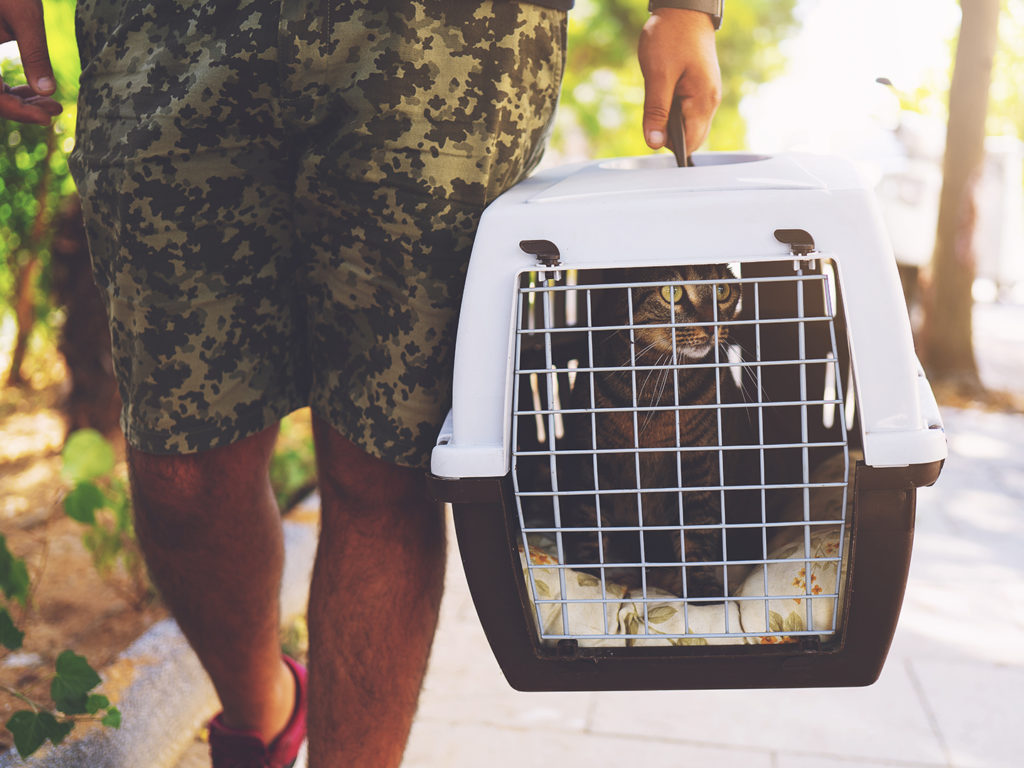Holiday Travel With Pets Part 2: How To Safely Fly With Your Pets

Whether it be for vacation getaways or seeing family and friends, the holidays are a great opportunity to travel. As people begin to pack their bags for this travel season, owners who plan to take their pets along with them should also begin preparing their furry friends for the travel experience.
Dr. Lori Teller, a clinical assistant professor at the Texas A&M College of Veterinary Medicine & Biomedical Sciences, says that owners wanting to take their pets with them by plane should first check with their airline before booking their flights.
“The only animals that can fly in the cabin are those that fit in a carrier under the seat (for a fee) and service dogs (no fee),” Teller said. “All other pets (i.e., larger dogs) have to fly in cargo in airline-approved, hard plastic crates with ventilation holes.
“Almost all airlines ban brachycephalic dogs (those with a short muzzle and flattened face) from flying, especially in cargo,” she said. “Some airlines ban other breeds as well (such as pit bulls).”
For domestic travel, the United States Department of Agriculture requires that a puppy or kitten be at least 8 weeks old and fully weaned before traveling by air. Airlines also can institute a higher age minimum requirement.
After checking with your airline, owners should check with their veterinarians to ensure that their pets are healthy enough for flying.
“If your pet has a chronic disease, such as diabetes or heart failure, then it is definitely worth asking your veterinarian if problems may result with management of the medical condition that could be exacerbated by air travel,” Teller said. “The changes in altitude can exacerbate cardiovascular or respiratory problems.”
When flying with pets, owners also should have a valid health certificate issued by a licensed veterinarian within 10 days of travel, as well as proof of rabies vaccination.
Pets will be required to travel in an airline-approved carrier. Each airline may have their own requirements, but, generally, animals should be in a hard plastic kennel with ventilation holes; some airlines will allow a blanket, towel, and/or toy in the crate, but others may not.
“It is very important that a pet owner makes sure their pet is acclimated to and calm while in the kennel,” Teller said. “For several weeks leading up to travel, owners can put their pets in the kennel with a favorite treat or feed them while they are in the carrier so that the pet associates being confined with good things.”
However, because pets are not allowed to have food and water in the carrier while flying, it is recommended that they have a small meal a couple hours before flying and that water be removed at that time.
Pet owners may also try driving around with their pet inside the kennel, so that they get accustomed to movement while inside.
“For animals that are flying, sedation is generally not advised because it can potentially interfere with an animal’s ability to breathe normally during changes in altitude or to regulate its body temperature,” Teller said. “Ultimately, the decision to give a sedative to a pet should be made between the pet owner and the veterinarian if the veterinarian thinks it is medically indicated.”
Once at the airport, dogs should be walked as close to check-in time as possible.
Taking the necessary precautions to ensure a pet’s physical and emotional health when traveling by airplane is one of the best ways owners can help turn a potentially hectic holiday travel season into an exciting adventure for their furry friends.
Pet Talk is a service of the College of Veterinary Medicine & Biomedical Sciences, Texas A&M University. Stories can be viewed on the web at vetmed.tamu.edu/news/pet-talk. Suggestions for future topics may be directed to vmbs-editor@tamu.edu.


